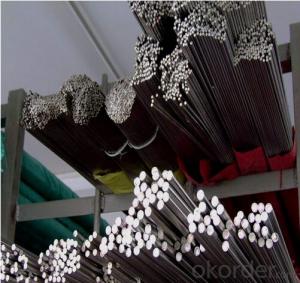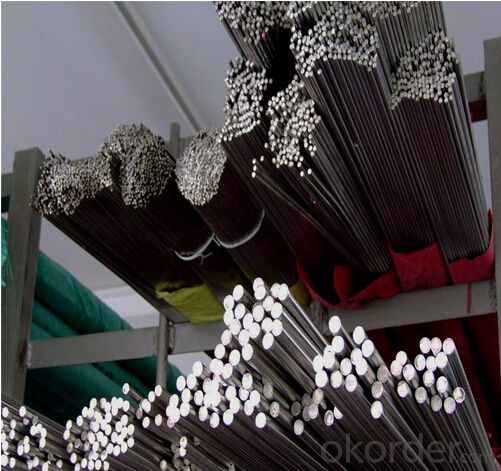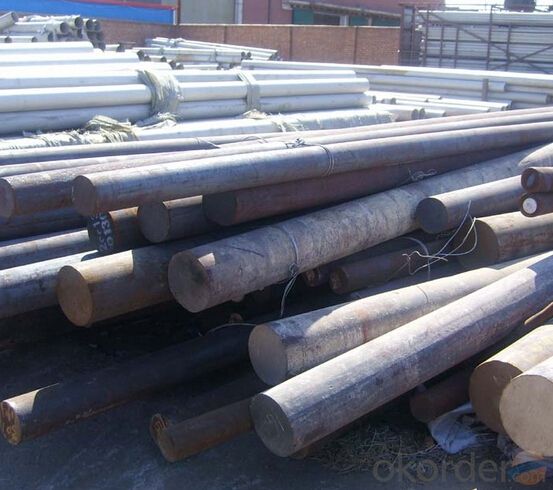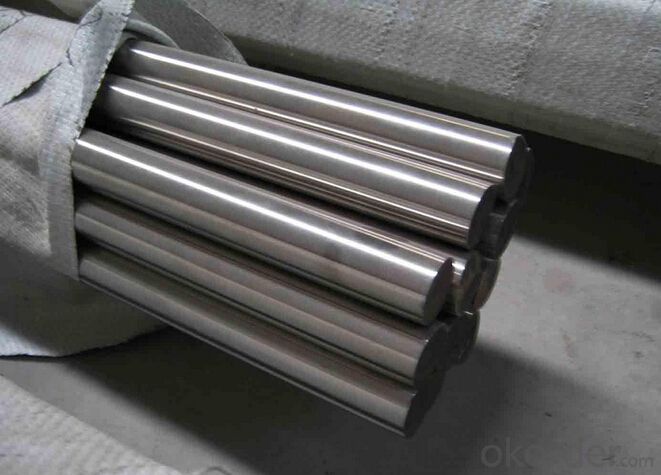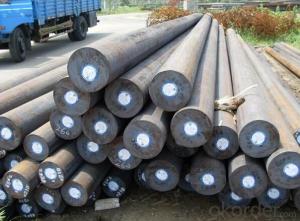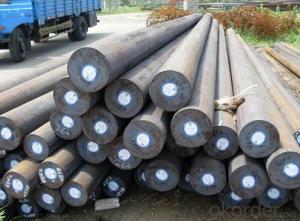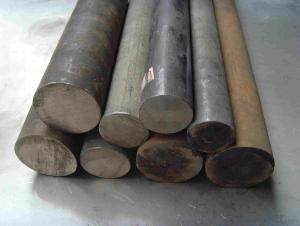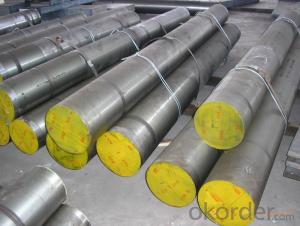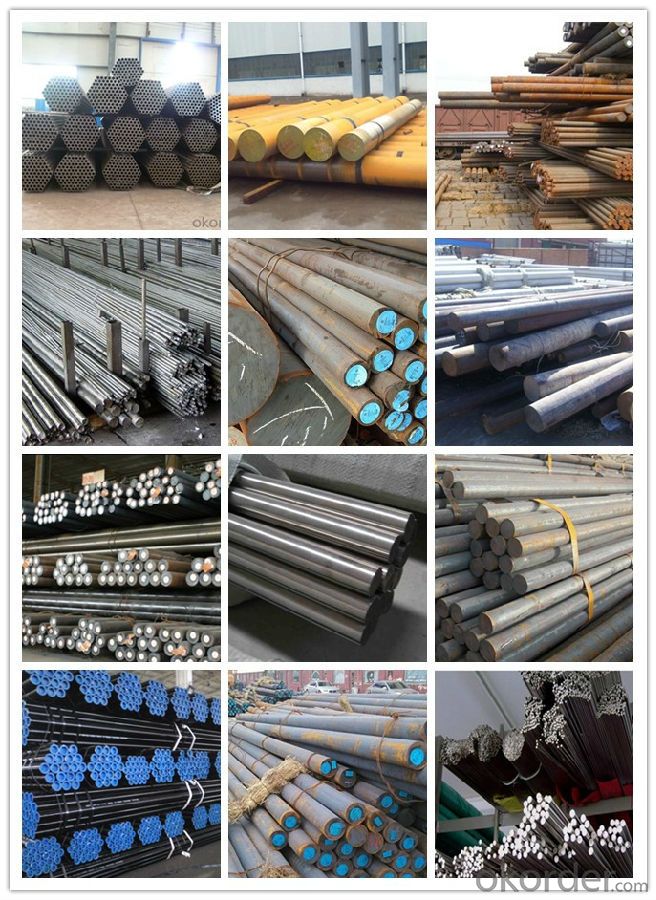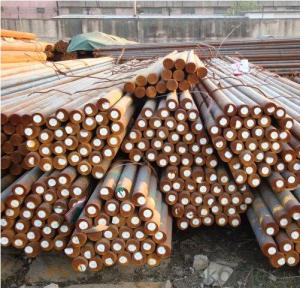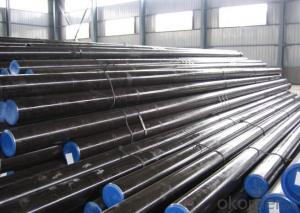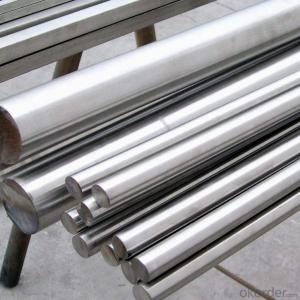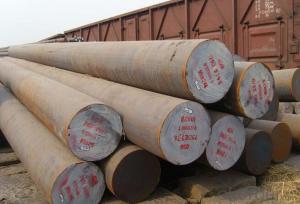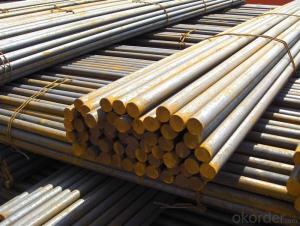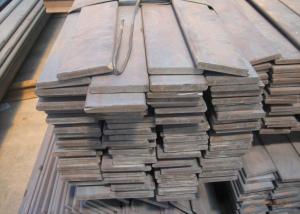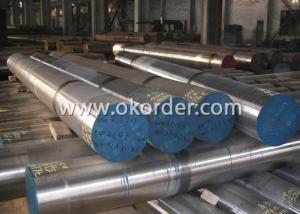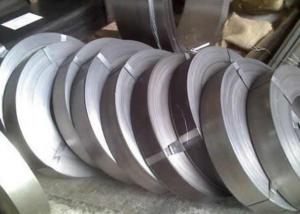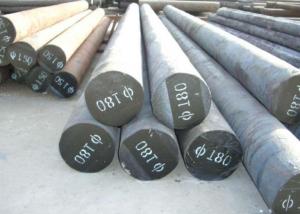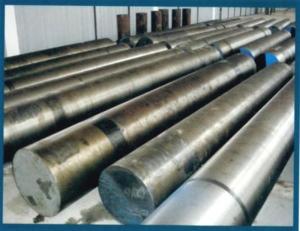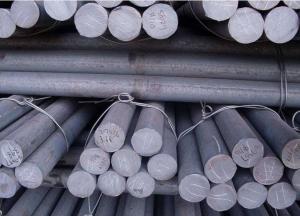Special Steel SAE1020 Alloy Structual Steel Round
- Loading Port:
- China main port
- Payment Terms:
- TT OR LC
- Min Order Qty:
- 30 m.t.
- Supply Capability:
- 10000 m.t./month
OKorder Service Pledge
OKorder Financial Service
You Might Also Like
Specification
Product information
Grade: | Carbon or alloy |
Dia.: | 10mm~1200mm |
Length: | Random or fixed as required |
Standard | GB,ASTM,JIS,BS |
Out Side Coating | Bare outside |
Ends | Plain ends with color painting |
Packing | Loose bundle |
Delivery | By container/train/lorry |
Third Party Inspection | SGS/BV/LORDS |
Delivery time | 7 days Min. |
Applications:
1. It is mainly used for manufacture of cold-work dies, punches, cold cutting scissors, drill bushes, gauges, wire-drawing dies, coining dies, draw bench boards, drawing dies, thread rolling dies, etc. with high abrasive resistance and small shock load.
2. It is used for processing of cutters made of materials which are not hard.
3. It is used for plastic moulds with high abrasive resistance and long service life.
Product show
Workshop show

Shipping
1. FedEx/DHL/UPS/TNT for samples, Door-to-Door;
2. By Air or by Sea for batch goods, for FCL; Airport/ Port receiving;
3. Customers specifying freight forwarders or negotiable shipping methods!
Delivery Time: 3-7 days for samples; 5-25 days for batch goods.
Payment Terms
1.Payment: T/T, L/C, Western Union, MoneyGram,PayPal; 30% deposits; 70% balance before delivery.
2.MOQ: 1pcs
3.Warranty : 3 years
4.Package Informations: 1) EXPORT, In 20 feet (GW 25 ton) or 40 feet Container (GW 25 ton)
2)as customer's requirement
Why choose us?
(1) The leading exporter in China special steel industry.
(2) Large stocks for various sizes, fast delivery date.
(3) Good business relationship with China famous factories.
(4) More than 7 years steel exporting experience.
(5) Good after-sales service guarantee.
- Q: How does special steel perform in cryogenic creep resistance?
- Special steels are known for their excellent cryogenic creep resistance. They exhibit minimal deformation and maintain their mechanical properties even at extremely low temperatures. This makes them highly suitable for applications in cryogenic environments where materials are subjected to significant stress over prolonged periods.
- Q: What are the properties of tungsten alloys?
- Tungsten alloys possess several notable properties, including exceptional hardness, high melting point, excellent corrosion resistance, and remarkable density. These alloys are also known for their exceptional strength, resistance to wear, and ability to retain their shape even under extreme temperatures. Furthermore, tungsten alloys exhibit good electrical and thermal conductivity, making them suitable for various applications in industries such as aerospace, automotive, and defense.
- Q: How does the carbon content affect the properties of special steel?
- The carbon content plays a crucial role in determining the properties of special steel. Higher carbon content tends to enhance its hardness, strength, and wear resistance. This is because carbon forms interstitial solid solutions with iron, creating stronger and more stable iron carbides. On the other hand, lower carbon content leads to increased ductility and toughness. The carbon content also influences the steel's ability to be heat-treated, affecting its response to processes like quenching and tempering. Therefore, controlling the carbon content allows manufacturers to tailor the properties of special steel to meet specific application requirements.
- Q: What are the challenges in heat treatment of special steel alloys?
- The heat treatment of special steel alloys poses several challenges due to their unique composition and properties. One of the main challenges is achieving the desired microstructure and mechanical properties while maintaining dimensional stability. Special steel alloys often have complex alloying elements and require specific heat treatment processes to achieve the desired properties. Another challenge is controlling the heating and cooling rates during the heat treatment process. Special steel alloys are often sensitive to rapid or uneven heating and cooling, which can result in distortion, cracking, or the formation of undesirable phases. Therefore, precise control of the heating and cooling rates is crucial to avoid these issues and ensure uniformity in the final product. Furthermore, the presence of alloying elements in special steel alloys can lead to increased hardenability, making it challenging to achieve the desired hardness throughout the entire component. Special attention needs to be given to the selection of appropriate heat treatment parameters, such as temperatures, soaking times, and quenching media, to achieve the desired hardness and avoid excessive hardness gradients. Additionally, special steel alloys are often prone to oxidation and decarburization during heat treatment due to their high alloy content and exposure to elevated temperatures. These reactions can lead to surface defects and a decrease in the carbon content, affecting the final properties of the alloy. Therefore, protective atmospheres or heat treatment environments must be carefully controlled to prevent such issues. Moreover, the size and geometry of components made from special steel alloys can pose challenges during heat treatment. Large or complex-shaped components require careful consideration of the heating and cooling methods to ensure uniformity of the microstructure and properties throughout the entire component. This may involve the use of specialized furnaces, fixtures, or heat treatment cycles to overcome these challenges. In conclusion, the challenges in heat treatment of special steel alloys include achieving the desired microstructure and mechanical properties, controlling heating and cooling rates, managing hardenability, preventing oxidation and decarburization, and addressing the size and geometry of components. Overcoming these challenges requires a deep understanding of the alloy's composition, properties, and the application of appropriate heat treatment techniques.
- Q: What are the main characteristics of magnetic steel forgings?
- The main characteristics of magnetic steel forgings are high strength, excellent wear resistance, and good magnetic properties. These forgings are known for their durability and ability to withstand extreme conditions. They also have good machinability and can be easily formed into various shapes.
- Q: What are the characteristics of special stainless steel?
- Special stainless steel distinguishes itself from regular stainless steel through its exceptional properties. Some of the notable traits of this type of stainless steel are as follows: 1. Unparalleled Resistance to Corrosion: Unlike regular stainless steel, special stainless steel boasts a higher degree of corrosion resistance. It can endure exposure to harsh surroundings, such as saltwater or acidic substances, without undergoing corrosion or deterioration. 2. Impressive Endurance of High Temperatures: Special stainless steel is engineered to withstand elevated temperatures without compromising its structural integrity. This makes it suitable for industries like aerospace, automotive, and power generation, where extreme heat endurance is essential. 3. Reinforced Strength and Durability: Special stainless steel is commonly alloyed with other elements to enhance its strength and durability. Consequently, it exhibits remarkable resistance to deformation, cracking, and wear, ensuring its longevity and reliability in demanding conditions. 4. Exceptional Mechanical Properties: Special stainless steel possesses outstanding mechanical properties, including high tensile strength, toughness, and ductility. These properties make it an ideal choice for applications that require a high load-bearing capacity, such as structural components and machinery. 5. Distinctive Magnetic Properties: Depending on its composition, special stainless steel can display a range of magnetic properties, varying from non-magnetic to highly magnetic. This versatility enables its use in applications that demand magnetic properties, such as magnetic resonance imaging (MRI) machines or electrical transformers. 6. Hygienic and Easy to Maintain: Special stainless steel is renowned for its hygienic properties, rendering it suitable for applications in the food and healthcare industries. It is non-porous, resistant to bacterial growth, and easy to clean, making it an ideal choice for equipment and surfaces that must meet stringent sanitary standards. 7. Aesthetic Allure: The aesthetic appeal of special stainless steel often leads to its utilization in architectural and design applications. It can be polished to achieve a mirror-like finish, lending it a sleek and contemporary appearance. Moreover, its malleability and weldability allow for limitless creative design possibilities. In conclusion, special stainless steel possesses an array of exceptional properties, encompassing high corrosion resistance, temperature resistance, strength, durability, excellent mechanical properties, unique magnetic properties, hygienic features, and aesthetic appeal. These characteristics position it as the preferred choice for a wide range of industrial, commercial, and domestic applications.
- Q: What are the properties of mold steel?
- Mold steel is known for its excellent hardness, wear resistance, and ability to withstand high temperatures. It possesses good machinability and can be easily polished or textured to create intricate mold designs. Mold steel also exhibits high toughness and dimensional stability, ensuring long-lasting and precise molds. Additionally, it is resistant to corrosion and offers good heat conductivity, making it suitable for various molding applications in industries such as automotive, aerospace, and consumer goods.
- Q: What are the different methods for nitriding special steel?
- There are several methods for nitriding special steel, including gas nitriding, salt bath nitriding, plasma nitriding, and ion nitriding.
- Q: What are the key differences between special steel and tool steel?
- Special steel and tool steel possess distinct characteristics and uses. Here are the main disparities: 1. Composition: Special steel encompasses a diverse range of steel alloys tailored for specific applications. Stainless steel, high-strength alloy steel, and heat-resistant steel are some examples. In contrast, tool steel refers to a particular type of special steel designed for tool, die, and mold production. Tool steel typically contains higher levels of carbon and other alloying elements like chromium, vanadium, or tungsten, which enhance its hardness, wear resistance, and toughness. 2. Hardness and wear resistance: Tool steel stands out for its exceptional hardness and wear resistance, making it ideal for cutting, shaping, and forming materials. It can endure high temperatures and resist deformation, ensuring the longevity of tools and dies. On the other hand, special steel may not possess the same level of hardness and wear resistance as tool steel. Its properties vary depending on the specific alloy and application. Special steel alloys may prioritize other properties such as corrosion resistance or strength. 3. Manufacturing processes: Tool steel often undergoes specialized manufacturing processes like hot working, cold working, or heat treatment to achieve the desired properties. The production of tool steel involves precise temperature control and cooling rates to attain the necessary hardness and toughness. In contrast, special steel may undergo various manufacturing processes depending on the desired properties, such as forging, casting, or heat treatment. 4. Applications: Tool steel finds primary application in the production of tools, dies, and molds used for cutting, shaping, and forming materials. Industries such as automotive, aerospace, and machinery commonly utilize tool steel. Conversely, special steel has a wide range of applications depending on the specific alloy and properties. It can be employed in industries such as construction, energy, and manufacturing, where specific properties like corrosion resistance, heat resistance, or strength are required. To summarize, the key distinctions between special steel and tool steel lie in their composition, hardness, wear resistance, manufacturing processes, and applications. While special steel encompasses various steel alloys with specific properties, tool steel is a specific type of special steel tailored for tooling applications. Tool steel is characterized by its exceptional hardness and wear resistance, making it suitable for cutting and shaping materials. On the other hand, special steel can possess a broader range of properties depending on the specific alloy and application.
- Q: How does special steel contribute to the manufacturing of springs for automotive applications?
- Special steel is crucial for the manufacturing of springs in automotive applications because it offers high strength, durability, and excellent fatigue resistance. It allows springs to withstand heavy loads, vibrations, and extreme temperatures while maintaining their shape and performance over time. Special steel also provides flexibility in design, allowing for the production of springs with specific characteristics such as improved stability, reduced weight, and enhanced energy absorption. Overall, the use of special steel in spring manufacturing ensures reliable and efficient performance in automotive applications.
Send your message to us
Special Steel SAE1020 Alloy Structual Steel Round
- Loading Port:
- China main port
- Payment Terms:
- TT OR LC
- Min Order Qty:
- 30 m.t.
- Supply Capability:
- 10000 m.t./month
OKorder Service Pledge
OKorder Financial Service
Similar products
Hot products
Hot Searches
Related keywords
